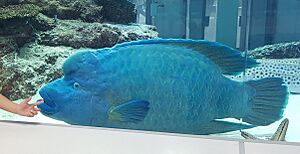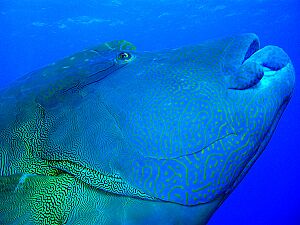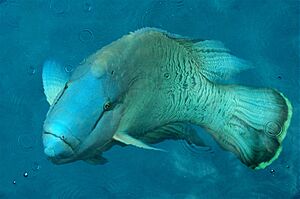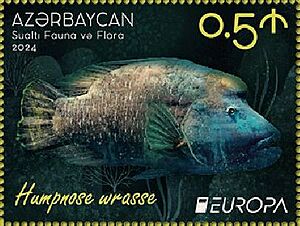Humphead wrasse facts for kids
Quick facts for kids Humphead wrasse |
|
|---|---|
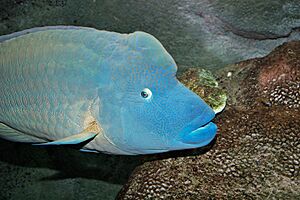 |
|
| Breeding male humphead wrasse in the Melbourne Aquarium | |
| Conservation status | |
| Scientific classification | |
| Synonyms | |
|
The humphead wrasse (Cheilinus undulatus) is a very large fish that lives on coral reefs. You can find it in the Indo-Pacific region, which includes parts of the Indian and Pacific Oceans. This amazing fish is also known by other names like the Māori wrasse, Napoleon wrasse, or Napoleon fish.
Contents
Discover the Humphead Wrasse: Appearance and Size
The humphead wrasse is the biggest fish in its family, called Labridae. Male wrasses are usually larger than females. They can grow up to 2 meters (about 6.5 feet) long and weigh as much as 180 kilograms (about 400 pounds)! However, most humphead wrasses are a bit smaller, usually less than 1 meter (about 3 feet) long. Females rarely grow bigger than 1 meter.
You can easily spot this fish because of its huge size and thick lips. It also has two black lines behind its eyes. Older adults have a noticeable hump on their foreheads, which is how they got their name. Their color can be a dull blue-green, or they can be bright green and purplish-blue. Adult wrasses often live alone, but sometimes you might see them in pairs or small groups.
Where Humphead Wrasses Live: Habitat
Humphead wrasses live in the warm waters of the Indo-Pacific. You can find them along the east coast of Africa, near the Red Sea, and in many parts of the Indian and Pacific Oceans.
Young humphead wrasses, called juveniles, usually live in shallow, sandy areas close to coral reefs. As they grow older, adult wrasses move to deeper parts of the coral reefs. They prefer the outer slopes and channels of the reef, but they can also be found in calmer lagoon areas.
Life Cycle and Reproduction
Humphead wrasses live a long time, but they don't have many babies. They can live for about 30 years! These fish become ready to have babies when they are about five to seven years old.
Interestingly, humphead wrasses are protogynous hermaphrodites. This means they are born female, and some of them can change into males later in life, usually around nine years old. Scientists are still learning what makes them change sex. At certain times of the year, adult wrasses gather together in groups at the end of the reef to lay their eggs. They probably don't travel very far to do this.
The eggs and tiny baby fish float in the ocean for a while. Then, they settle down on or near coral reefs. The eggs are very small, about 0.65 millimeters wide, and have no color.
What Humphead Wrasses Eat: Ecology
Humphead wrasses are very good at finding food. They mostly eat small sea creatures without backbones, like snails, clams, sea urchins, crabs, and worms. They also eat other fish.
Since many of their favorite foods hide under the sand, wrasses have clever ways to find them. They might follow other fish, like stingrays, that dig in the sand. Or, they can squirt water out of their mouths to move the sand and then search for prey. Humphead wrasses are known to pick up sea urchins in their mouths and hit them against rocks to crack them open!
Sometimes, these wrasses even hunt together with other fish, like the roving coral grouper. This is called cooperative hunting.
Adult humphead wrasses are commonly found on steep coral reef slopes and in channels. They live in water from about 1 to 100 meters (3 to 330 feet) deep. Young wrasses like to hide in places with lots of branching corals, bushy seaweeds, or seagrasses. Older and larger wrasses prefer more open areas on the edges of reefs and channels.
Protecting the Humphead Wrasse: Conservation Efforts
The humphead wrasse is an endangered species. This means its numbers have dropped a lot, and it's at risk of disappearing forever. It's listed on the IUCN Red list and in Appendix II of CITES, which are important lists for protecting animals.
Many things threaten the humphead wrasse:
- Too much fishing: People catch too many of them, especially for the live reef food-fish trade in Southeast Asia.
- Bad fishing methods: Some fishers use harmful methods like bombs or cyanide, which hurt the reefs and other sea life.
- Loss of homes: Their coral reef homes are being damaged or destroyed.
- Food demand: People in some areas see them as a special food, which increases fishing.
- Aquarium trade: Young wrasses are sometimes caught to be sold for home aquariums.
- Lack of rules: There isn't enough teamwork or strong rules to protect them across different countries.
- Not enough knowledge: We still need to learn more about this species to protect it better.
- Illegal fishing: Fishing that is against the rules, not reported, or not controlled.
The biggest problem is too much fishing for the live reef food fish trade. For example, in Sabah, on Borneo Island, the number of humphead wrasses has dropped by about 99% because of fishing. To help, Sabah has banned exporting humphead wrasses. However, illegal fishing still happens.
Organizations like the Convention on International Trade in Endangered Species of Wild Fauna and Flora (CITES) help manage protection. In Malaysia, laws like the Fisheries Act 1985 and the International Trade in Endangered Species Act 2008 help control fishing and ban harmful methods.
The humphead wrasse is considered an "umbrella species." This means that protecting its home also helps protect many other species that live in the same area. Understanding this idea can help us protect more endangered animals.
In Australia, the humphead wrasse used to be fished a lot, but it has been protected in Queensland since 2003 and in Western Australia since 1998. Other countries like Indonesia, the Maldives, Papua New Guinea, and Niue also have rules or bans to protect this fish. In Taiwan, hunting or killing the humphead wrasse can lead to big fines and even jail time since 2014.
Genetics and Population Health
After its population dropped quickly, the humphead wrasse was put on the endangered species list in 1996. Scientists are now studying the fish's genes to help keep the species alive.
Researchers are looking at the wrasse's genetic information to understand how different groups of wrasses are related across the ocean. This helps them figure out the best ways to protect the species.
Illegal Fishing and Trade
The Philippines, Indonesia, and Sabah (in Malaysia) are the biggest places where humphead wrasses are caught and sold. This fish is very valuable, especially when caught alive, and it's seen as a special food in places like Malaysia.
Even though it's illegal to export them, humphead wrasses are still smuggled across borders, like between Malaysia and the Philippines. This illegal trade continues because:
- Not enough people or rules: There aren't enough officials to watch fishing activities and make sure rules are followed.
- No other options: Fishers don't have other ways to make money that are as good as catching these valuable fish. Also, the punishments for illegal fishing might not be strong enough to stop them.
- Hard to track: Many people are involved in selling the fish, so it's hard to find out where it came from. This makes it difficult to hold people responsible for illegal trade.
- Weak local rules: Rules about catching, owning, and selling the fish within a country might not be strict enough. Fishers might catch the fish illegally but can't be stopped if they have permits for other activities.
In some areas of Malaysia, humphead wrasses can be bought for a lot of money, and their retail price is even higher.
See also
- Green humphead parrotfish (Bolbometopon muricatum)
- List of animals with humps



